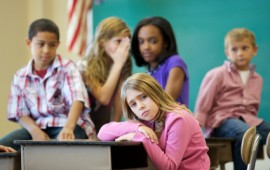National Bullying Prevention Month
Author: Shannon Miller Lifestyle

School-aged children children across our great country are getting training from their school teacher or counselor about bullying and bullying prevention during the month of October.
Please be sure to ask your child what they learned about bullying at school, and if they have not gotten a bullying awareness training from their school,
You have the right as a parent to talk to your child about bullying and to ask your school to address bullying prevention and bullying education at the school.
Most schools have a specific guideline for bullying and bullying prevention. For example, Brazosport Independent School District in Texas defines bullying as “consistent behavior that targets a specific child in a negative way.” Though this definition seems broad, it does reduce the amount of isolated incidences labeled as “bullying.” An isolated incident could be just that; a disagreement between children or a misunderstanding. Isolated incidences should be handled differently from consistent bullying behavior.
When generation X and older were kids, they were taught, “sticks and stones may break my bones, but names will never harm me,” comments were often brushed aside as “kids being kids.”
Now counselors and professionals recognize several different types of harmful bullying:
- Physical bullying. This is the typical bullying story of a kid getting physically “picked on.” Physical bullying can be consistent physical harm to a child, or a threat of physical harm. “If you don’t give me your milk money, I will beat you up,” will qualify in this category.
- Verbal bullying. This is a child or a group of children who calls another child or group of children ugly names. It is also consistent teasing and taunting, purposeful ignoring, and any behavior that demoralizes and demeans a child.
- Cyber bullying. This is the newest discovered way for kids to bully each other. Spreading ugly rumors or sending ugly and demeaning messages are included in cyber bullying. This is an easy way for kids to pick on each other, because they feel like they can hide behind a computer screen or phone while saying terrible things or spreading ugly rumors.
What can you do to find out if your child is affected by bullying:
First of all, ask questions and notice the following:
- Is your child becoming more shy and withdrawn?
- Does your child seem upset about something?
- Is your child hanging out with a new group that you are not sure about?
- Is your child a loner, or seem to have no friends?
Ask your child questions about his or her day on a daily basis:
- What did you do today?
- Who did you play with?
- What did you play?
- Who are your friends?
- Is there anyone at school that is not your friend? Why do you think that?
If your child is old enough to have a cell phone or a social network account, it is your right and responsibility as a parent to know who he or she is visiting with. You have the right to check the cell phone for text messages, and to “friend” your child so that you see what kind of cyber conversations he or she is having.
What to do if I think my child is being bullied?
The next step is to get details from your child about the consistency of the behaviors involved. If your child is withdrawn and does not want to share with you, call the school and ask the counselor to visit with your child. The counselor will be responsible for keeping other children’s names from you, but she can follow up with the children on both parties, as well as schedule separate meetings for the parties involved.
Stay involved in your child’s daily activities. The more you talk, the more she may open up. Be totally non-judgmental, but let her know that you know something is wrong and you want to help. You may get a lot of “Mom, you don’t understand!” But the more you talk, the more she may see that you do understand.
Educate your child on bullying. Take her to the Pacer Center’s Kids Against Bullying Site, where you can watch videos that help kids see what bullying really is, and it helps them feel like they are part of a large organization, not all alone in this.
Watch the movie or read the book: Chrissa Stands Strong, an American Girl Book and movie. In the story, the heroine Chrissa sees that another child is the victim of bullying, and decides to stand up for what is right.
What if I think my child is a bully?
If you get the suspicion that your child is bullying someone else, it is your responsibility to intervene. Make it very clear that bullying is not “kids being kids,” and share the above-mentioned anti-bullying information. Call your child’s counselor or another third party, and ask that they counsel your child on better ways to make friends. If you are part of a religious organization or group, use lessons learned from that group to remind your child what it is that you believe in. Encourage your children daily to make choices that help, not hurt.
We must all take bullying awareness seriously. Bullying can cause children to have a hard life.
Bullied children often:
- develop low self-image
- become withdrawn
- can become depressed or suicidal
It is important to recognize bullying as an EMERGENCY situation. Kids cannot handle this on their own. They need support and friendships. Unfortunately, some children who have not gotten help in time have resorted to substance abuse, gang activity, and in some cases, suicide.
SML TIP: Do not brush aside the signs of childhood bullying. Do something positive today.
Do you have other bullying awareness resources that you have found helpful with your children? Please add a Comment and share them with us.
